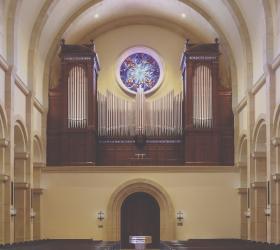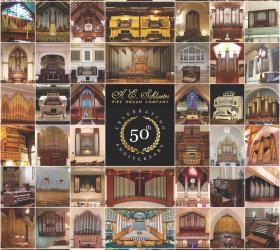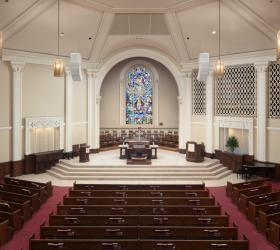
Gober Organs, Inc., Elora, Ontario, Canada
The Lutheran Church of the Good Shepherd (ELCA), Brooklyn, Ohio
The classic form of the tracker organ, with a slender lower case and wider upper case, the transition made elegant by curved consoles or brackets, has become iconic. But if we take in the whole range of historic organs, the number that deviate from that scheme is great. Organs with the keydesk detached, off-center, on the side of the case or the rear of the case, make up a very significant portion of historic organs. Then, as now, the physical situation often suggested a layout other than the one we now tend to regard as the norm.
The Lutheran Church of the Good Shepherd in the Cleveland, Ohio, suburb of Brooklyn has no loft. The choir and other musicians are located behind the congregation and at the same level. First efforts to design an asymmetrical organ on one side of the aisle were fruitless. Such a design would have cramped the pipes and not got them far enough up over the heads of the people to take advantage of the acoustic volume of the high-ceilinged sanctuary.
Once our proposed organ straddling the aisle was accepted, the engineering was a matter of reconciling all our normal principles: simplifying the action, eliminating mass and friction, devising a layout that produces a dramatic façade with good proportions and strong geometric patterns and that relates to the windchest pipe order. The resulting action is not only pleasant to play, but also stable through the extreme humidity changes between winter and summer in the un-air conditioned sanctuary.
The Hauptwerk and Pedal are at impost level, with the Hauptwerk on the left just above the keyboards, and the Pedal on the right. The Oberwerk is above and centered in the case. Façade pipes are taken from the Hauptwerk and Pedal Prinzipal 8' and 16' stops as well as the Pedal Choralbass and the Oberwerk Traversflöte 8', a harmonic flute. Seated at the organ, the player is on a podium two steps up from floor level, facilitating her view of the choristers or other musicians.
The organ is North German in style. Most of its pipes are of lead, made in our shop, including the hand-burnished façade pipes, plus several stops, revoiced, from the church’s previous organ. The sanctuary’s overall acoustical dryness is compounded at floor level by a number of windows. But the 28-foot tall organ benefits, as we had hoped, from the much more supportive environment overhead.
The organ was selected by a committee headed by Linda Kempke, cantor and parish assistant at Good Shepherd. They were assisted in their work by consultant David Boe of the Oberlin Conservatory, who also played the dedication recital. The organ can be heard on a forthcoming CD recorded by Craig Cramer of the University of Notre Dame.'
—Halbert Gober
Hauptwerk C–g3
16' Bourdon
8' Praestant
8' Viola da Gamba
8' Gedackt
4' Oktav
3' Quinte
2' Oktav
Mixtur IV
8' Trompete
Oberwerk C–g3
8' Rohrflöte
8' Traversflöte
4' Koppelflöte
2' Spitzflöte
Sesquialtera II
8' Dulzian
Pedal C–f1
16' Prinzipal
16' Subbass
8' Oktav
6' Nasat
4' Choralbass
2' Nachthorn
16' Posaune
8' Trompete
Normal couplers
Tremulant to entire organ
Zimbelstern, wind-driven




